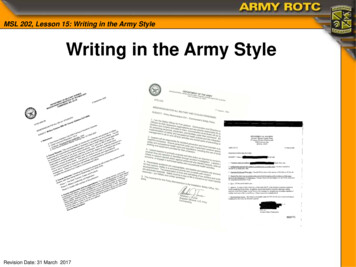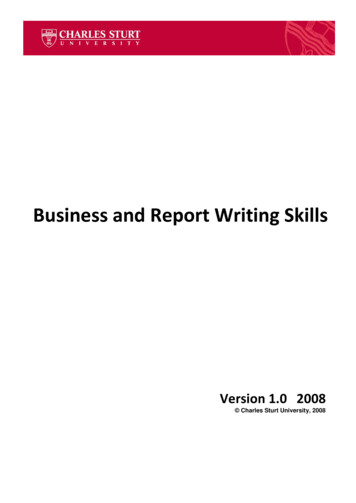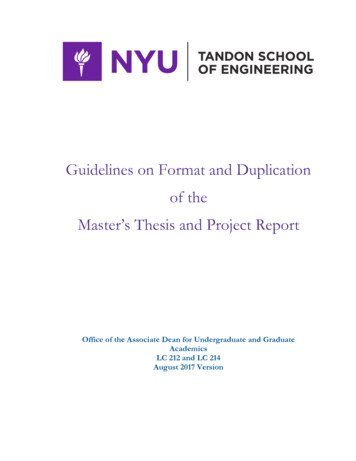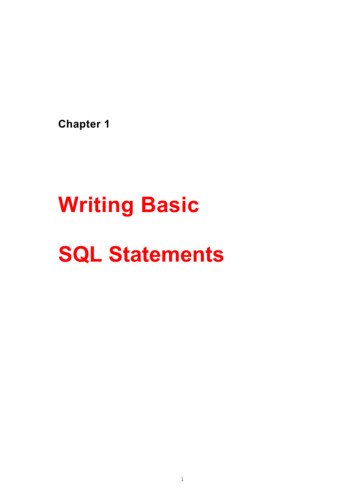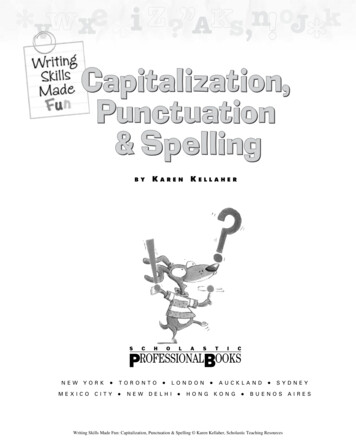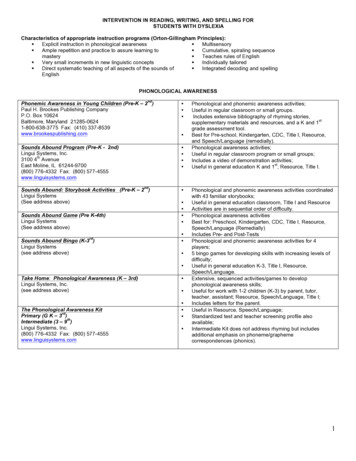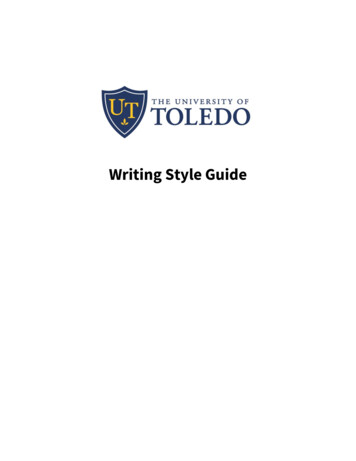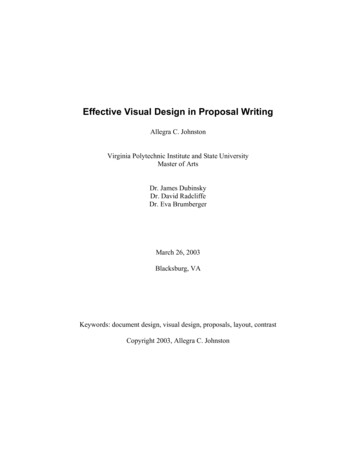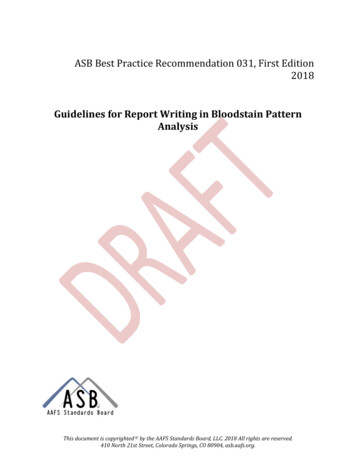
Transcription
ASB Best Practice Recommendation 031, First Edition2018Guidelines for Report Writing in Bloodstain PatternAnalysisThis document is copyrighted by the AAFS Standards Board, LLC. 2018 All rights are reserved.410 North 21st Street, Colorado Springs, CO 80904, asb.aafs.org.
ASB Best Practice Recommendation 031, 1st Ed. 2018Guidelines for Report Writing in Bloodstain Pattern AnalysisASB Approved Xxxxx 2018ANSI Approved Xxxxx 2018410 North 21st StreetColorado Springs, CO 80904This document may be downloaded for free at: http://asb.aafs.org/This document is provided by the AAFS Standards Board for free. You are permitted to print anddownload the document and extracts from the document for your own use, provided that: you do not modify this document or its related graphics in any way; you do not use any illustrations or any graphics separately from any accompanying text; and, you include an acknowledgement alongside the copied material noting the AAFS Standards Boardas the copyright holder and publisher.You expressly agree not to reproduce, duplicate, copy, sell, resell, or exploit for any commercialpurposes, this document or any portion of it. You may create a hyperlink to http://asb.aafs.org toallow persons to download their individual, free copy of this document. Your hyperlink must notportray AAFS, the AAFS Standards Board, this document, our agents, associates and affiliates in anoffensive manner, or be misleading or false. You may not use our trademarks as part of your linkwithout our written agreement for you to do so.The AAFS Standards Board retains the sole right to submit this document to any other forum for anypurpose.Certain commercial entities, equipment or materials may be identified in this document to describe aprocedure or concept adequately. Such identification is not intended to imply recommendations orendorsement by the AAFS or the AAFS Standards Board, nor is it intended to imply that the entities,materials, or equipment are necessarily the best available for the purpose.This document is copyrighted by the AAFS Standards Board, LLC. 2018 All rights are reserved.410 North 21st Street, Colorado Springs, CO 80904, asb.aafs.org.
ASB Best Practice Recommendation 031, 1st Ed. 2018ForewordThis document provides guidelines for report writing in Bloodstain Pattern Analysis (BPA). Inaddition, it provides guidance regarding statements to be avoided in the report. It has beenprepared by the Organization of Scientific Area Committees (OSAC) Subcommittee on BloodstainPattern Analysis based on a document originating with the Scientific Working Group on BloodstainPattern Analysis (SWGSTAIN).All hyperlinks and web addresses shown in this document are current as the publication date ofthis standard.Keywords: report, case information, methods, limitations, assumptions, observations, analysis,conclusions, reviewAbstract: The purpose of this document is to provide a guide for the report content and issuanceof Bloodstain Pattern Analysis (BPA) reports. It is not intended to set forth a specific format forreport writing.
ASB Best Practice Recommendation 031, 1st Ed. 2018Table of Contents1Scope . 12Normative References . 13Terms and Definitions . 14Requirements . 14.1 Preamble . 14.2 Report Elements. 24.3 Review and Issuance . 64.4 Other Considerations . 6Annex A (informative) Bibliography . 8
ASB Best Practice Recommendation 031, 1st Ed. 2018Guidelines for Report Writing in Bloodstain Pattern Analysis1 ScopeThis document provides guidelines for report writing in bloodstain pattern analysis (BPA). Inaddition, guidance is provided regarding statements to be avoided in the report.2 Normative ReferencesASB Technical Report 033, Terms and Definitions in Bloodstain Pattern Analysis, First Edition,November 20173 Terms and DefinitionsFor purposes of this document, the following definitions apply.3.1bloodstain pattern analysis terminologyRefer to the ASB TR 033, Terms and Definitions in Bloodstain Pattern Analysis document for all termsspecific to BPA.3.2shallUsed to indicate that a provision is mandatory.3.3shouldUsed to indicate that a provision is not mandatory, but recommended as good practice.4 Requirements4.1 PreambleThis document summarizes the elements to be contained within a written BPA report. Generalconsiderations when generating BPA reports include the following. The report shall be written clearly without misleading language or jargon. The report format shall be designed to minimize confusion. Reports authored by multiple parties shall identify and define the role of each contributor. Headings should be standardized within the agency. ASB TR 033 shall be used for bloodstain pattern analysis terminology, all terminology referencesshall be defined and referenced. This may be accomplished by the use of footnotes, an appendixor glossary, or defined within the body of the report. When the conclusions rely in part on the results of examinations reported by third parties (e.g.,DNA, pathology, and fingerprint) a reference to these results shall be included in the BPA report.1
ASB Best Practice Recommendation 031, 1st Ed. 2018Quotations from associated documents (e.g., witness statements) shall be clearly defined andreferenced. Case-related experimentation and findings shall be reported. The page number should appear on each page of the report and the total number of pages shouldbe defined. Abbreviations and acronyms not commonly recognized should be fully defined upon first use(e.g., Bloodstain Pattern Analysis [BPA]). Any corrections or additions to the original report shall be identified and issued as an amendedor supplemental report.4.24.2.1Report ElementsTitleThe report shall identify the subject matter of the document. For example: “Bloodstain Pattern Analysis Report,” “Report of Findings,” “Supplemental Report,” “BPA Case Experimentation Report.”4.2.2Case IdentifierThe report shall have a unique case identifier displayed on each page of the report. The requestingagency’s case identifier should be displayed on the first page.4.2.3Name and Address of Reporting AgencyThe name and address of the reporting agency shall be included.4.2.4Date of ReportThe date of the report shall be included.4.2.5Case InformationThe report should outline the background information pertinent to BPA and question(s) posed to theanalyst during the course of the investigation and analysis. This should include, but is not limited tothe following. Information supplied by submitting agency and when the information was supplied, that is,before, during or after the examination, analysis, and/or report. Medical/DNA information.2
ASB Best Practice Recommendation 031, 1st Ed. 2018 Environmental conditions. Explanation of how the author(s) became involved in the case. Summary of case background and source(s) of this information. Name and address of the submitting agency or requesting officer.4.2.6Items4.2.6.1 The report shall include a list of the items of evidence or materials reviewed during thebloodstain pattern analysis. This should include but is not limited to the following: unambiguous identification (e.g., item number, serial number, individual identifier(s), etc.); evidence examined: physical description (e.g., size, color, etc.); reported recovery location, if applicable; materials reviewed: medical/autopsy reports, laboratory reports, investigative reports, photographs.4.2.6.2 The extent to which the items are further described within the report may be casedependent (e.g., damp condition, moldy, soiled, fabric damage, fabric type, etc.).4.2.6.34.2.7The date and manner of receipt of items should be included.Location of Tests or ExaminationsThe report shall identify the locations where examinations took place. For example: “The scene was located at (address) ” “I examined the following items at (agency location) ”4.2.8MethodsThe report should list the method(s) utilized in the examination. The extent of method description(or reference) in the report is agency and jurisdiction dependent. For example: “Phenolphthalin, a presumptive test for blood, was employed.” “An area of origin was determined utilizing a forensic software technique ”3
ASB Best Practice Recommendation 031, 1st Ed. 2018 “Infrared photography was utilized ”4.2.9Limitations and AssumptionsThe report shall include statements of any evidence limitations and assumptions (e.g., photographicreview, evidence condition, lack of DNA testing, etc.). For example: “Limitations may exist when basing any conclusions on photographic evidence alone.” “The potential for contamination caused by multiple items packaged together limited thebloodstain pattern analysis.” “Numerous sampled bloodstains failed to yield DNA profiles and, as such, have restricted a morecomprehensive analysis.” “All red brown stains are assumed to be blood.”4.2.10 Observations4.2.10.1 The report shall include the observations recorded in the course of the BPA whichprovide the basis for the conclusions.Each general location where observations are recorded should be addressed separately in thissection. The subsections defined here will be case dependent. For example: crime scene divided into logical subsections (e.g., by room, areas within a room, etc.); victim/deceased; physical evidence (e.g., victim’s clothing, suspect’s clothing, etc.).4.2.10.2 The report should include descriptors of reported stains and stain patterns. The extentand manner of stain or pattern description is agency dependent. For example: “Numerous bloodstains less than “x” millimeters in size were present ” “Elliptical shaped bloodstains were present ” “A linear distribution of bloodstains was present ”4.2.10.3 References such as cardinal points shall be incorporated into the description of stain andpattern locations.4.2.10.4 Measurements—Measurements should be included in the report when needed to assistthe reader in understanding observations and may be reported using the system commonlyemployed in that jurisdiction. Measurements utilized for calculations such as area of origin shall beincluded in the report.4.2.10.5 Photographs—Photographs should be utilized to assist in reporting of observations. Ifused in a report, photographs shall be identified and may be annotated. Any alteration tophotographs utilized in a report shall be noted.4
ASB Best Practice Recommendation 031, 1st Ed. 20184.2.10.6 Sketches—Sketches, scene diagrams, or floor plans should be included if created. If used,these shall be identified and referenced in the report. Sketches may be annotated.4.2.10.7 Absence of bloodstains—The absence of bloodstains should be reported if relevant to theconclusions.4.2.11 Analysis4.2.11.1 GeneralExaminations conducted in the course of a BPA which provide a basis for the conclusions shall beincluded in the report.4.2.11.2 Chemical applicationsThe results of any chemical application (e.g., chemical enhancements, presumptive blood testing, etc.)shall be reported. For example: “Leuco-Crystal Violet (LCV) was applied to (location or item) and this revealed.” “Presumptive testing for blood was positive on the stains located on.”4.2.11.3 ClassificationAny classified bloodstain patterns shall be included in the BPA report. The classification shouldreference the stain and pattern descriptors.4.2.11.4 Collected SamplesThe location(s) of stain sample(s) collected by the analyst, if not reported elsewhere, shall bereported with reference to their unique identifier(s).4.2.12 Case ConclusionsWhen rendering case conclusions, the report shall include the findings drawn from the analysis andbe based upon the information and observations previously presented in the report. Justification(s)shall be clearly stated in the conclusion. For example: “The directionality of the drip stains and flow patterns of blood observed on the clothing wornby the deceased indicated s/he was in an upright position while bleeding.”4.2.13 Qualifying StatementsA statement should be included acknowledging that, if information changes, the conclusionsrendered in the original report may be affected. For example: “This report is based solely on the information and materials made available at this time and maybe modified with the submission of new information.” “This statement is based on information provided to me during this investigation. If furtherinformation becomes available, (I/the analyst) may need to reappraise (my/the) findings and5
ASB Best Practice Recommendation 031, 1st Ed. 2018conclusions. If such a reappraisal were required, it would be more effective carried out in advanceof any trial.”4.2.14 SignatureEach report shall have the name and signature of the reporting analyst(s).4.3Review and IssuanceEach report shall be subjected to a technical [peer] and administrative review prior to release. Allreview(s) shall be documented. All reviewer(s) and dates of review should be noted in the report.Reports should be issued prior to providing expert testimony.4.44.4.1Other ConsiderationsUnsubstantiated conclusionsUnsubstantiated conclusions and opinions shall not be included. For example: “The bloodstains on the front door handle established the victim attempted to leave theresidence.” “The victim was shot in bed while sleeping.” “The presence of back spatter indicated a non-jacketed round was used.” “Based on the extent of bloodstaining at the scene, the perpetrator would have been covered inblood.” “The cast-off pattern showed the assailant was right handed.”4.4.2Omission of Information Analysts shall not consciously omit information that does not support conclusion(s).4.4.3Author’s Area of ExpertiseStatements made outside the author’s area of expertise shall not be included. For example: “The victim was not capable of purposeful movement due to the large volume of blood loss.” “The victim would not have been able to walk due to their blood alcohol level.”4.4.4Use of Emotive or Biased LanguageUse of emotive or biased language shall not be included. For example: “The bloodstain patterns indicated this was a vicious attack.” “The presence of bloodstains on the clothing items worn by Ms. X showed she was the assailantin this brutal crime as indicated in the investigative reports.”6
ASB Best Practice Recommendation 031, 1st Ed. 20184.4.5Use of Unsubstantiated DataThe use of unsubstantiated data shall not be included. For example: “The blood spatter on Mr. X’s clothing indicated he was less than two meters away from the victimat time of impact.” “Based upon the size of the bloodstain pattern on the bed, a minimum of two liters of blood waspresent.” “The presence of clotting within spatter stains showed that bleeding had commenced more thanX minutes prior to impact.”7
ASB Best Practice Recommendation 031, 1st Ed. 2018Annex A(informative)Bibliography1] Scientific Working Group on Bloodstain Pattern Analysis: Guidelines for Report Writing inBloodstain Pattern Analysis, issue date July 7, 2012.8
Academy Standards Board410 North 21st StreetColorado Springs, CO 80904http://asb.aafs.org/
410 North 21st Street, Colorado Springs, CO 80904, asb.aafs.org. . Abstract: The purpose of this document is to provide a guide for the report content and issuance of Bloodstain Pattern Analysis (BPA) reports. It is not intended to set forth a specific format for
